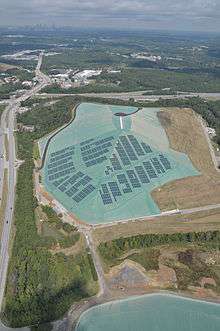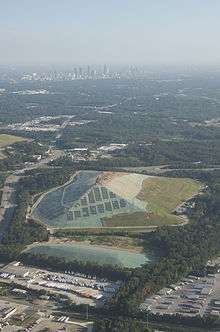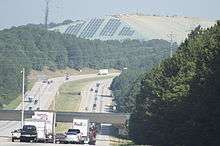Hickory Ridge Landfill
| Hickory Ridge Landfill | |
|---|---|
 Photo of completed project taken on 9/23/2011. Atlanta can be seen in the background. | |
 Location of Hickory Ridge Landfill in Georgia (U.S. state) | |
| Country | United States |
| Location | Conley, Georgia |
| Coordinates | 33°39′54″N 84°20′06″W / 33.66500°N 84.33500°WCoordinates: 33°39′54″N 84°20′06″W / 33.66500°N 84.33500°W |
| Status | Operational |
| Construction began | 6/1/2011 |
| Commission date | 10/4/2011 |
| Construction cost | $5,000,000 |
| Owner(s) | Republic Services, Inc. |
| Solar field | |
| Type | Ground Mount, Flexible PV |
| Site area | 48 acres |
| Power generation | |
| Units operational | 7,008 UNI-SOLAR PVL-144 photovoltaic laminates |
| Nameplate capacity | 1,009 KW |
| Average generation | 1.3 GWh |
|
Website http://carlisle.kiosk-view.com/hickory-ridge | |
The Hickory Ridge Landfill is a municipal solid waste landfill located in Conley, Georgia, United States and privately owned by Republic Services. The site was opened in 1993 and closed in 2006; it contains nearly 9,000,000 cubic yards of waste.



The Hickory Ridge Landfill was formerly capped in October 2011 with an innovative patent-pending, dual-purpose landfill closure system referred to as an Exposed Geomembrane Solar Cover (EGSC). Developed by Carlisle Energy Services, a division of Carlisle Construction Materials, the closure system, branded the Spectro PowerCap(R), provides both long-term environmental benefits with integrated solar cells (photovoltaics) that generate clean, renewable electricity.
The project is the second installation of an EGSC and is the world's largest installed system of its kind. At the time of commissioning it was the largest solar photovoltaic system in the state of Georgia.[1] It also represents a $5,000,000 investment by Republic Services supported by a $2,000,000 grant from the Georgia Environmental Finance Authority (GEFA).[2]
System Details
The innovative landfill closure system features a Dark Ivy green, 60-mil scrim reinforced TPO (thermoplastic polyolefin) geomembrane cover over 48 acres in total. Within this area, an integrated one-megawatt (MWp) photovoltaic array is located on the southwest and southeast slopes of the landfill in an area approximately ten acres.[3]
The one-megawatt solar array features over 7,000 flexible solar laminates manufactured by UNI-SOLAR(R), a division of Energy Conversion Devices. UNI-SOLAR's photovoltaic laminates were shipped to Carlisle's manufacturing facility in Senatobia, MS where 36 laminates were factory bonded at a time to 12' wide by 120' long TPO geomembrane panels and finished with wire harnesses and a patent-pending low profile rain flap. The panels were subsequently packaged in rolls and shipped to the site prior to construction. Each photovoltaic/geomembrane roll was rated at 5,184 Wp DC.
During construction the photovoltaic/geomembrane rolls were unrolled and heat-welded to like panels of TPO geomembrane to create a monolithic cover over the entire landfill. The geomembrane is placed directly over a 16 ounce Geotextile that is placed directly over the final grade. The cover system is secured via horizontal and vertical anchor trenches designed by HDR Inc.[4]
The closure system meets infiltration and erosion criteria as prescribed by the United States Environmental Protection Agency, Title 40, Part 258, Subpart F for municipal solid waste landfill closure systems while also capturing the methane gas that is generated by the landfill, turning it into energy in a separate operation. The Georgia Environmental Protection Division approved the landfill closure system as a "Final" closure system.[5]
The photovoltaic system is actually composed of four separate arrays located on the 3H:1V slopes on the southeast and southwest areas of the landfill. Each photovoltaic array is rated for approximately 250kWp DC each; each with a 260kWp DC inverter. The system also features a patent-pending low-profile wire trace used for carrying the conductors from the photovoltaic laminates to the combiner boxes prior to connecting the inverters.
The site is approximately seven miles southeast of downtown Atlanta, Georgia and can be seen during landing approach (west to east direction) into Atlanta's Hartsfield-Jackson airport.
The system is wholesale interconnected with electricity being sold directly to Georgia Power. The photovoltaic array is expected to generate 1,300,000 kWh in its first year of production.[6] The electricity generated from the system is equivalent to powering 224 homes while reducing over 1,102 tons of CO2 annually.[7]
Real-time energy production can be viewed via the online remote monitoring system.
Media Coverage
- "Solar-Powered Landfills" news report from energyNOW! that appeared on Bloomberg TV
- CNN: Solar landfill provides a shining example
- Scientific American: Solar energy covers turn maxed-out landfills into solar farms
- EastAtlantaPatch: From Landfill To Solar Energy Farm
- Waste360: Preview of the Solar Installation at Hickory Ridge
- Fox News: Trash Today, Electricity Tomorrow, Thanks to Landmark Solar Energy Farm
Key Project Partners
The following companies helped to develop, engineer and construct the system:[8]
- Site owner and operator: Republic Services, Inc.
- State Permit Agency: Georgia Environmental Protection Department
- Grant Agency: Georgia Environmental Finance Authority
- Permit Engineer: HDR Inc
- Project Developer and Technology Supplier: Carlisle Energy Services
- Construction Manager: Geosyntec Consultants
- General and Earthwork Contractor: Cooper Barnette Page, Inc.
- Liner Installer: American Environmental Group, Ltd.
- Electrical Contractor: Southern SunPower
Awards
HDR Inc. received the following awards for their engineering work on this project:[9]
- 2012 - Grand Award, Engineering Excellence Awards, American Council of Engineering Companies of Georgia
- 2012 - Honor Award, Engineering Excellence Awards, American Council of Engineering Companies
- 2012 - Honor Award, American Academy of Environmental Engineers
American Environmental Group (AEG) received the 2013 Award of Excellence from the International Association of Geosynthetic Installers (IAGI) for their work as the geomembrane installer for the project
Related
- See actual energy produced by the Spectro PowerCap at the Hickory Ridge Landfill via the Online Remote Monitoring System
- View an actual time-elapsed construction video of the Hickory Ridge project
- Read a recent article about solar and landfills titled "Fill of Energy" that was published in PV Magazine in July 2012
- Read an announcement for a Spectro PowerCap that was recently installed at the Madison County Landfill in New York
- Read the details of the first installed Exposed Geomembrane Solar Cover at the Republic Service's Tessman Road Landfill in San Antonio, TX
- Mas Energy secured the landfill gas rights for the Hickory Ridge Landfill from Republic Services, supplying fuel to their 6.5 Megawatt combined heat and power facility located at Coca-Cola's Cogen Plant in Atlanta, GA.[10] Coca-Cola ranked third in the Top 20 Onsite Green Power Generators by the U.S. EPA Green Power Partnership as of July 5, 2012 mainly because of this system and the landfill gas from Hickory Ridge[11]
References
- ↑ "Georgia's Largest Solar Project Is a Landfill-Covering System". Electrical Contractor. Retrieved 5/1/2011. Check date values in:
|access-date=(help) - ↑ "From Landfill To Solar Energy Farm". 10/5/2011. EastAtlantaPatch.
- ↑ "Solar Powered Landfills". Energy Now News. Retrieved 2011-10-31.
- ↑ "Hickory Ridge Landfill Solar Energy Cover". HDR Inc.
- ↑ "Hickory Ridge Landfill Solar Energy Cover". HDR Inc.
- ↑ "Republic Services Caps Atlanta Landfill with Flexible Solar Cover". PR Newswire. Retrieved 10/4/2011. Check date values in:
|access-date=(help) - ↑ "Green Power Equivalency Calculator". United States Environmental Protection Agency. Retrieved May 2011. Check date values in:
|access-date=(help) - ↑ "Case Study: Republic Hickory Ridge Landfill". Carlisle Energy Services, Inc. Retrieved 11/1/2012. Check date values in:
|access-date=(help) - ↑ "Hickory Ridge Landfill Solar Energy Cover". HDR Inc. Retrieved 2012. Check date values in:
|access-date=(help) - ↑ "Coca-Cola Cogen Plant". Mas Energy. Retrieved 5 August 2012.
- ↑ Signet, Anna. "Landfill gas ranks Coca-Cola third in EPA green power users". Biomass Magazine. Retrieved 8/9/2012. Check date values in:
|access-date=(help)